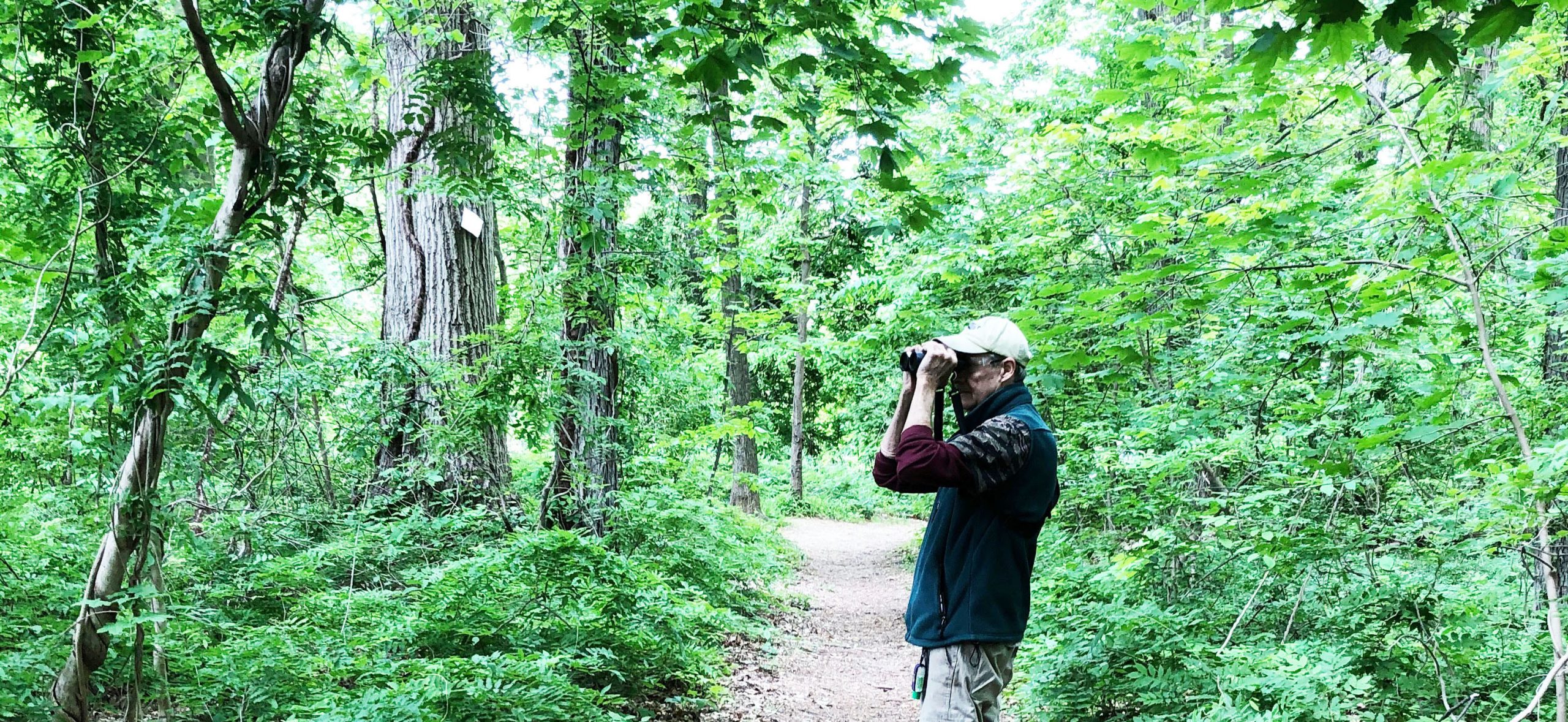By Elizabeth Smith, Whitman Woods Project Manager
The birding adventures of professional New Jersey Field Guide Lloyd Shaw span the southern end of the Garden State, with Cape May a prime destination for the popular forays he normally leads during Spring Migration. However, during the pandemic, the 64-year-old naturalist has been happily counting birds solo at aspirational Whitman Woods. Located just a few blocks from Shaw’s Laurel Springs home, the 3.75-acre woodland oasis is a rare remnant of the new near-relic native Inner Coastal Plain Forest.
Shaw likes to think that he is following in Poet Walt Whitman’s legendary footsteps. Whitman, a winter resident of Camden City, famously sought renewal here along Big Timber Creek over many consecutive summers in the twilight of his life. He took great joy in walking the creek bank (now Laurel Lake), counting birds, taking mud baths and studying the passing clouds. Indeed, the influences of the Natural World Whitman encountered here between 1876 and 1882 resonate through the centuries in his most legendary works, primarily Specimen Days and portions of Leaves of Grass.
During the current pandemic, many city and suburb dwellers complying with stay-at-home guidelines have followed Whitman’s lead by seeking solace and sunshine in nearby local parks. Birding and hiking can be tonics for the soul at anytime, but especially now.
As a member of the Whitman Woods Project Advisory Board and a native “Springer,” Shaw is intimately acquainted with the Laurel Springs site that, with adequate funding, will be preserved as a passive park. His daily visits since mid-April have yielded 90 species thus far. He even camped out during the height of Spring Migration.

Shaw’s “Big Day” was May 15 (also “Endangered Species Day”) when he spotted 60 species over 24 hours. Among the tally that includes a Bald Eagle, he says seeing 11 species of wood warblers (colorful little songsters) and 2 shorebird species “mining” the mud 50 miles west of the Atlantic Ocean was most notable. Yet most moving was the choral recital. “To be treated to such a symphony of beautiful birdsong on my home turf, even if just for a short interlude, was extraordinary,” Shaw enthuses. “Hearing tanagers, thrushes, flycatchers, vireos, warblers and so many others singing simultaneously was truly wondrous, even miraculous, considering the location.”
Lying 15 miles due east of Philadelphia in Camden County and just south of the densely developed Route 30 corridor, “Whitman Woods” is considered a “green island” in an urban/suburban landscape. Comprised of a soaring canopy of oak, beech, poplar and black walnut, crisscrossed with timeworn footpaths and blessed with water resources, the site possesses the desired ambiance for a passive park.
Indeed, this private land has been considered a park in all but name for the past 50 years. Area residents seek sanctuary here. Children experience wildlife here, recite poetry here, draw and paint here. Canoes are launched here. Naturalists bird here. Shutterbugs document Nature here.
Peace is found here.

As wild places yield to development, and as scientists grapple with the connection between the disruption of natural ecosystems, habitat destruction, wildlife trade and the COVID-19 pandemic, restoring nature to neighborhoods is more important than ever.
Although the pandemic’s root causes may seem far removed, we are reminded that habitat destruction can have a health cost, too. The CDC recognizes that “staying physically active is one of the best ways to keep your mind and body healthy.” Communing with nature also gives us time for reflection, which Whitman found integral to penning his celebrated free verse.
Shaw is reflective. “I’m so happy to have these woods so nearby. It’s my hope that people will come to realize the importance of having nature close to home. Tangible and accessible and centering — not just as a remote destination that requires a day trip. We’ve all found comfort in nature over the last two months. What does that tell you about coping in times like these? Hopefully, we can all hold onto our newfound love of nature. Let that be the new normal!”
Saving the site from development will be a profoundly organic conservation solution for the last significant parcel of undeveloped woodland along a lakeshore where Whitman found enduring inspiration. Securing an owner/steward to protect the woods in perpetuity is the goal of the family that has owned the land since 1925.
For more information, visit the Whitman Woods website.
NALT serves as a lead Whitman Woods project adviser and a chief conservation collaborator.


